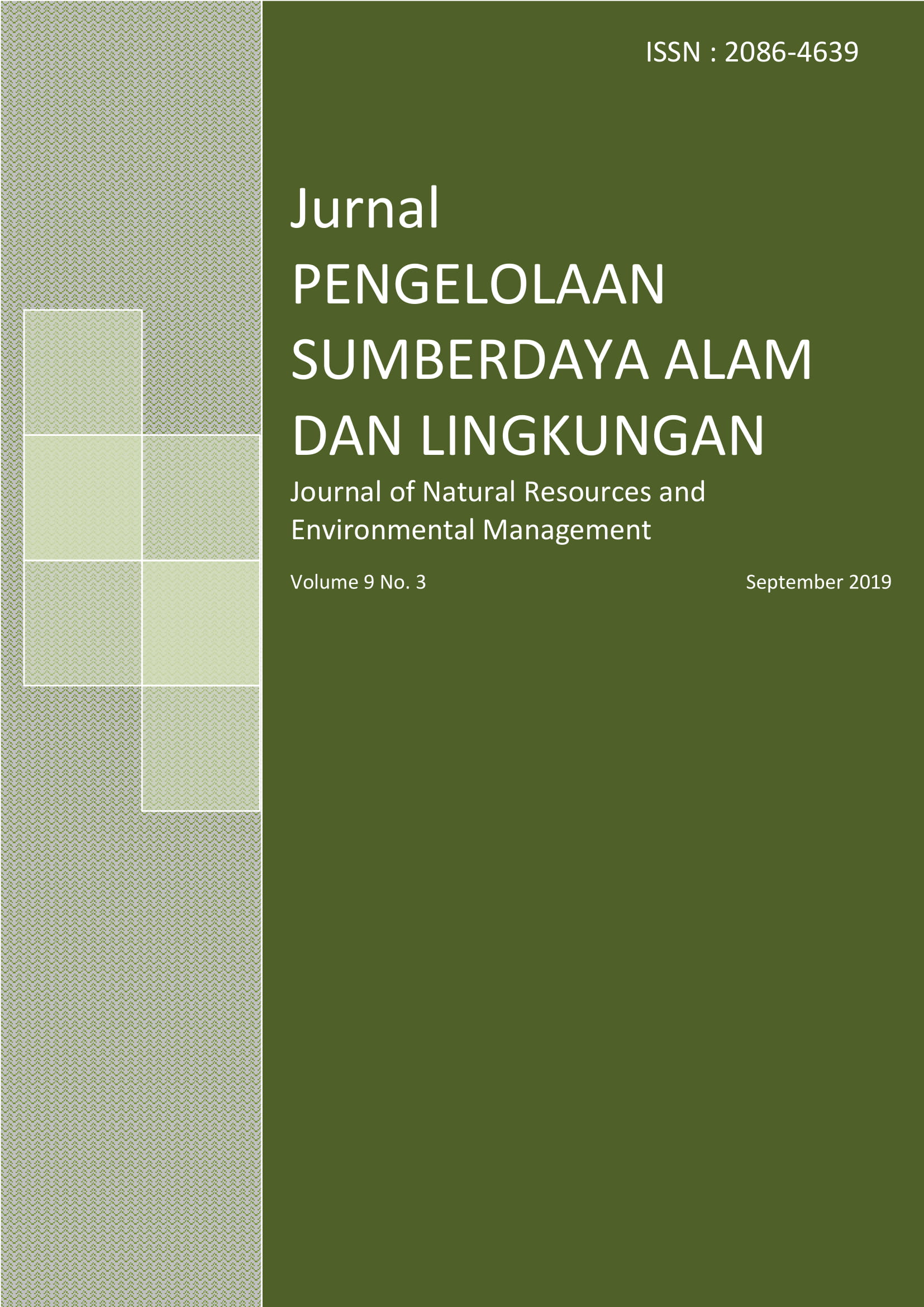Struktur dan Komposisi Vegetasi di Habitat Cemara Laut (Casuarina equisetifolia L.) pada Tiga Kawasan Konservasi di Provinsi Bengkulu
Abstrak
Referensi
Diagne, N., D. Diouf, S. Svistoonoff, A. Kane, K. Noba, C. Franche, D. Bogusz, R. Duponnois, 2013. Casuarinas in Africa: distribution, role and importance of abuscular mycorrhizal, ectomycorrihizal fungi and Frankia on plant development. J Environ Manage 128, pp. 204-209.
Diem, H. G., E. Duhoux, H. Zaid, M. Arahous, 2000. Cluster roots in Casuarinaceae: role and relationship to soil nutrient factors. Annals of Botany 85, pp. 929-936.
Eze, J. M. O., M. O. Ahonsi, 1993. Improved germination of the seeds of whistling pine (Casuarina equisetifolia) forst and forst (Cassuarinaceae) by various presowing treatments. J Agronomie 10 (13), pp. 889-894.
Everitt, B., S. Landau, M. Leese, D. Stahl, 2011. Cluster Analysis. 5th Edition. John Wiley & Sons, Chichester.
Friis, I. B., 1980. The authority and date of publication of genus Casuarina and its type species. Taxon 22 (4), pp. 499-501.
Golam, S. A. K. M., H. Araki, 2010. Monotypic taxa, their taxonomic implications and conservation needs in Bangladesh. Proc ICRAB 10, pp. 55-57.
Gunawan, W., S. Basuni, A. Indrawan, L. B. Prasetyo, H. Soedjito, 2011. Analisis komposisi dan struktur vegetasi terhadap upaya restorasi kawasan hutan taman nasional gunung gede pangrango. JPSL 2 (1), pp. 93-105.
Hanin, A., 2011. Pengaruh Penyiraman air laut terhadap bibit nyamplung (Calophyllum inophylum). Tekno Hutan Tanaman 4(2), pp. 79-84.
Indriyanto., 2006. Ekologi Hutan. Bumi Aksara, Jakarta.
Jamaludheen, V., B. M. Kumar, 1999. Litter of multipurpose trees in Kerala, India: variations in the amount, quality, decay rates and release of nutrients. Forest ecology and management 115, pp. 1-11.
Karthikeyan, A., B. Deeparaj, P. Nepolean. 2009. Reforestation in Bauxite mine spoils with Casuarina equisetifolia frost. And Beneficial Microbes. Forest, Tree and Livehoods 19(2), pp. 153-165.
Karthikeyan, A., 2016. Frankia strains for improving growth, biomass and nitrogen fixation in Casuarina equisetifolia seedlings. J Trop For Sci 28(3), pp. 135-142.
Koorders, S. H., 1909. Some systematic and phytogeorgraphical notes the Javanese Casuarinaceae, especially of the State Herbaria at Leiden and at Utrecht. (contribution to the knowledge of the Flora of Java III). Proc KNAW 11: 415-426.
Kusmana, C., 1997. Metode Survey Vegetasi. Institut Pertanian Bogor Pr, Bogor.
Liu, X., Y. Lu, Y. Xie, Y. Xue, 2015. The positive interaction between two nonindigenous species, Casuarina (Casuarina equisetifolia) and Acacia (Acacia mangium), in the tropical coastal zone of south China: stand dynamics and soil nutrients. Trop Conserv Sci 8(3), pp. 598-609.
Ludwig, J. A., J. F. Reynolds, 1988. Statistical Ecology a Premier on Methods and Computing. J Wiley, Canada.
Magurran, A. E., 2004. Measuring biological diversity. Blackwell, Oxford.
Maun, M. A., 2009. The Biology of Coastal Sand Dunes. Oxford Univ Pr, Great Britain.
Master, J., S. R. Tjitrosoedirdjo, I. Qayim, 2013. Ecological impact of Merremia peltate (L) Merrill Invasion on plant diversity at Bukit Barisan Selatan National Park. Biotropia 20(1), pp. 29-37.
Mukhlisi., K. Sidiyasa, 2011. Aspek ekologi nyamplung (Calophyllum inophyllum L.) di Hutan Pantai Tanah Merah, Taman Hutan Raya Bukit Soeharto. Jurnal Penelitian Hutan dan Konsevasi Alam 8(3), pp. 385-397.
Nuitja, I. N. S., J. D. Lazell, 1982. Marine turtle nesting in Indonesia. Copeia 3, pp. 708-710.
Romesburg, H., 1984. Cluster Analysis for Researchers. Belmont. Wadsworth Inc, California.
Samin, A. N., Chairul, E. Mukhtar, 2016. Analisis vegetasi tumbuhan pantai pada kawasan wisata Pasir Jambak, Kota Padang. Biocelebes 10(2), pp. 32-42.
Soerianegara, I., A. Indrawan, 1988. Ekologi Hutan Indonesia. IPB Pr, Bogor.
Suwarsono., Supriati, Suwardi, 2011. Zonasi karakteristik kecepatan abrasi dan rancangan teknik penanganan jalan lintas barat Bengkulu bagian utara sebagai jalur transportasi vital. Makara Teknol 15 (1), pp. 31-38
Tagawa, H., E. Suzuki, T. Partomihardjo, A. Suriadarma, 1985. Vegetation and succession on the Krakatau Islands, Indonesia. Vegetation 60(3), pp. 131-145.
Tani, C., H. Sasakawa, 2003. Salt Tolerant of Casuarina equisetifolia and Frankia Ceg1 Strain Isolated from the Root Nodules of C. equisetifolia. Soil Sci.Plant Nutr 49(2), pp. 215-222.
Torrey, J. G., 1982. Casuarina: actinorhizal nitrogen fixing tree of the tropics. In Graham P.H. and Harris S.C. (eds.). Biol Nit Fix Technol Trop Agric, pp. 427-439.
Penulis
Authors who publish with this journal agree to the following terms:
- Authors retain copyright and grant the journal right of first publication with the work simultaneously licensed under a Creative Commons Attribution License that allows others to share the work with an acknowledgement of the work's authorship and initial publication in this journal.
- Authors are able to enter into separate, additional contractual arrangements for the non-exclusive distribution of the journal's published version of the work (e.g., post it to an institutional repository or publish it in a book), with an acknowledgement of its initial publication in this journal.
- Authors are permitted and encouraged to post their work online (e.g., in institutional repositories or on their website) prior to and during the submission process, as it can lead to productive exchanges, as well as earlier and greater citation of published work (See The Effect of Open Access).






